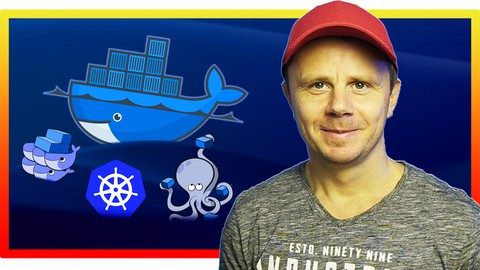
Docker & Kubernetes: The Complete Practical Guide
Docker & Kubernetes: The Complete Practical Guide, available at $94.99, has an average rating of 4.7, with 246 lectures, based on 1055 reviews, and has 22357 subscribers.
You will learn about How to use Docker images and create Containers Manage Docker containers: start, stop, prune, restart Enable port mapping and expose container ports to outside Run Node and Python applications using Docker Containers Create environment variables for Docker containers Use volumes mapping and use specific working directories in the Docker containers Create custom bridge networks and run multiple containers Communicate between containers by container name in the custom bridge network This course is ideal for individuals who are Any software developers It is particularly useful for Any software developers.
Enroll now: Docker & Kubernetes: The Complete Practical Guide
Summary
Title: Docker & Kubernetes: The Complete Practical Guide
Price: $94.99
Average Rating: 4.7
Number of Lectures: 246
Number of Published Lectures: 246
Number of Curriculum Items: 246
Number of Published Curriculum Objects: 246
Original Price: $119.99
Quality Status: approved
Status: Live
What You Will Learn
- How to use Docker images and create Containers
- Manage Docker containers: start, stop, prune, restart
- Enable port mapping and expose container ports to outside
- Run Node and Python applications using Docker Containers
- Create environment variables for Docker containers
- Use volumes mapping and use specific working directories in the Docker containers
- Create custom bridge networks and run multiple containers
- Communicate between containers by container name in the custom bridge network
Who Should Attend
- Any software developers
Target Audiences
- Any software developers
This course is all about Docker and Kubernetes
Understand HOW Docker and Kubernetes work and learn their core features ON PRACTICE. This is 90% practice course without no useless demos!
Learn how to create different containers like Node.js, Python, WordPress, MongoDB, MySQL, Redis, Elasticsearch and much more.
Become a master of Docker and Kubernetes by understanding and practicing their main features.
All project files are available in the GitHub repository.
We will start by installing Docker on your computer – MacOS, Windows or Linux. On MacOS and Windows you will install Docker Desktop, on Linux you will install Docker Engine.
Afterwards we will jump into tons of practice activities and use different Docker features. You will pull different docker images and run multiple containers using them.
In practice sections you will perform multiple practice Docker activities:
-
Run Docker containers in foreground and background
-
Connect to certain process in the Docker from the Terminal
-
Expose internal container ports to outside
-
Add environment variable for container
-
Create custom names and hostnames for container
-
Create custom bridge network and run multiple containers inside of it
-
Communicate between containers
-
Persist containers folders using volumes mapping
You will also learn and practice how to use following Docker images
-
Ubuntu
-
Alpine, Busybox
-
Node.js
-
Python
-
MongoDB
-
MySQL, phpMyAdmin
-
NGINX
-
WordPress
-
Elasticsearch
-
Redis
-
Httpd
During the course you will need to view and edit text files. For that you will NOT use terminal. Instead you will use GUI application VisualStudio Code. Also all project files are available in the GitHub repository. This means that during this course you will also learn how to use
-
Git and GitHub
-
VisualStudio Code
With this course you will get lifetime-long access to more than 50 lectures and tens of practical exercises. After the course you will get fundamental practical knowledge of Docker and be able to easily use it for development and testing of your applications.
But most important is that you will UNDERSTAND Docker main features like
-
Docker Volumes
-
Docker Networking
-
Environment Variables
Also you will UNDERSTAND Kubernetes main features like
-
Pods
-
Nodes
-
Cluster
-
Services
You will also get 30-days money-back guarantee. No questions asked!
Don’t wait and join the course now!
Course Curriculum
Chapter 1: Introduction
Lecture 1: Course introduction
Lecture 2: Let's get connected! Join the Learning Community
Lecture 3: GitHub Repository for the Docker course
Lecture 4: IMPORTANT Course Structure
Chapter 2: Docker Installation
Lecture 1: CHAPTER 1 – Installing Docker Desktop on Mac
Lecture 2: Installing Docker Desktop on Windows
Lecture 3: Installing Docker Engine on Linux
Chapter 3: Basic Docker Containers (Ubuntu, Busybox, Alpine)
Lecture 1: Running hello-world container
Lecture 2: Running Ubuntu container
Lecture 3: Running Busybox container
Lecture 4: Alpine vs Busybox images
Chapter 4: Port and Volume Mapping in the Docker Containers
Lecture 1: Running Nginx with exposed port
Lecture 2: Nginx container with custom content
Lecture 3: Adding favicon to the project
Lecture 4: WINDOWS: using path variable
Lecture 5: Using path variable in volume mapping
Chapter 5: Docker Containers Management (Ubuntu, NGINX)
Lecture 1: Running containers in background
Lecture 2: Running container with Pseudo TTY
Lecture 3: Creating multiple Ubuntu containers from the same image
Lecture 4: Running multiple Nginx servers
Lecture 5: Cleaning up stopped containers
Chapter 6: Running Python Applications in Docker
Lecture 1: Creating Python containers
Lecture 2: Simple Python program
Lecture 3: CHALLENGE Simple Python calendar app
Lecture 4: CHALLENGE SOLUTION Simple Python calendar app
Chapter 7: Running Node.js Applications in Docker
Lecture 1: Running Node.js container
Lecture 2: Hello world application with Node
Lecture 3: Express web server using Node
Lecture 4: Add handling of the SIGINT and SIGTERM signals
Lecture 5: CHALLENGE Create files handling Node app
Lecture 6: CHALLENGE SOLUTION Create files handling Node app
Lecture 7: Conclusion – containers can create and modify external files
Chapter 8: Running MongoDB Containers
Lecture 1: Pulling Mongo image and creating first Mongo container
Lecture 2: Starting additional processes in the running container
Lecture 3: What is entrypoint and where is it located
Lecture 4: Creating new Mongo database using Mongo shell
Lecture 5: Running Mongo container with persistent database
Chapter 9: Communication between Containers and Environment Variables (MySQL, phpMyAdmin)
Lecture 1: Starting WordPress container
Lecture 2: Plan for the next lectures – networks and environment variables
Lecture 3: Default bridge network and communication between containers
Lecture 4: Exploring environment variables
Lecture 5: Starting MySQL container with env variable
Lecture 6: Launching another phpMyAdmin container
Lecture 7: Connecting phpMyAdmin to MySQL container
Lecture 8: Making notes of the commands
Chapter 10: Default and Custom Bridge Networks in Docker (WordPress, MySQL)
Lecture 1: Communication using hostnames in the default bridge network
Lecture 2: Inspecting default bridge network
Lecture 3: Creating new custom bridge network
Lecture 4: Creating busybox containers in the custom network
Lecture 5: Using custom persistent names for connectivity in the custom network
Lecture 6: MySQL and phpMyAdmin in the custom network
Lecture 7: CHALLENGE WordPress with MySQL and phpMyAdmin
Lecture 8: CHALLENGE SOLUTION WordPress with MySQL and phpMyAdmin – PART 1
Lecture 9: CHALLENGE SOLUTION WordPress with MySQL and phpMyAdmin – PART 2
Lecture 10: Summary for the WordPress and MySQL setup
Chapter 11: Additional Containers – Elasticsearch, Redis, Httpd
Lecture 1: Getting docker image with curl utility
Lecture 2: CHALLENGE Run Elasticsearch and curl containers in the custom network
Lecture 3: CHALLENGE SOLUTION Run Elasticsearch and curl containers in the custom network
Lecture 4: Inserting documents into Elasticsearch index
Lecture 5: Starting Redis container
Lecture 6: CHALLENGE Redis and Redis-commander
Lecture 7: CHALLENGE SOLUTION Redis and Redis-commander
Lecture 8: Launching httpd container
Chapter 12: CHAPTER 2 – Docker on Practice Summary and Intro to the Docker Fundamentals
Lecture 1: Docker Fundamentals Practical section summary
Lecture 2: Introduction to the Docker Fundamentals Chapter
Chapter 13: What is Docker and Docker Components
Lecture 1: Virtual Machines vs Docker Containers
Lecture 2: Virtual Machines Architecture
Lecture 3: How I use Virtual Machines
Lecture 4: My computer just ran out of memory
Lecture 5: Docker Containers Architecture
Lecture 6: How Docker is running on different Operating Systems
Lecture 7: Container Processes and Resources
Lecture 8: Docker Components Overview
Lecture 9: Docker Client
Lecture 10: Docker Server
Lecture 11: Docker Host
Lecture 12: Docker Image
Lecture 13: Docker Container
Lecture 14: Docker Repository
Lecture 15: Docker Registry
Lecture 16: Docker Components Summary
Chapter 14: Introduction to the Images and Containers
Lecture 1: Docker Commands vs Management Commands
Lecture 2: Alternative Commands
Lecture 3: Basic Container and Images commands
Lecture 4: Cleaning up my Docker setup
Lecture 5: Pulling images from the Docker Hub
Instructors
-

Bogdan Stashchuk | Software Engineer, MBA, PhD
Just keep learning – stashchuk
Rating Distribution
- 1 stars: 6 votes
- 2 stars: 8 votes
- 3 stars: 61 votes
- 4 stars: 289 votes
- 5 stars: 691 votes
Frequently Asked Questions
How long do I have access to the course materials?
You can view and review the lecture materials indefinitely, like an on-demand channel.
Can I take my courses with me wherever I go?
Definitely! If you have an internet connection, courses on Udemy are available on any device at any time. If you don’t have an internet connection, some instructors also let their students download course lectures. That’s up to the instructor though, so make sure you get on their good side!
You may also like
- Digital Marketing Foundation Course
- Google Shopping Ads Digital Marketing Course
- Multi Cloud Infrastructure for beginners
- Master Lead Generation: Grow Subscribers & Sales with Popups
- Complete Copywriting System : write to sell with ease
- Product Positioning Masterclass: Unlock Market Traction
- How to Promote Your Webinar and Get More Attendees?
- Digital Marketing Courses
- Create music with Artificial Intelligence in this new market
- Create CONVERTING UGC Content So Brands Will Pay You More
- Podcast: The top 8 ways to monetize by Podcasting
- TikTok Marketing Mastery: Learn to Grow & Go Viral
- Free Digital Marketing Basics Course in Hindi
- MailChimp Free Mailing Lists: MailChimp Email Marketing
- Automate Digital Marketing & Social Media with Generative AI
- Google Ads MasterClass – All Advanced Features
- Online Course Creator: Create & Sell Online Courses Today!
- Introduction to SEO – Basic Principles of SEO
- Affiliate Marketing For Beginners: Go From Novice To Pro
- Effective Website Planning Made Simple




















